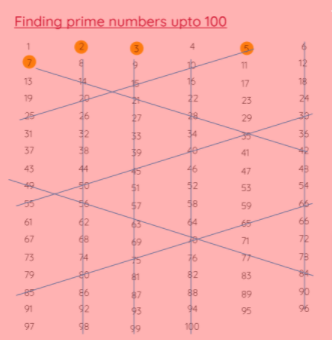Finding a Number is Prime or not in the case of smaller numbers is quite easy. But when it comes to larger numbers it can be a bit tricky. Don’t worry as this article covers the information on how to find if a number is prime or not for both smaller and larger numbers. Refer to the different methods used for finding prime numbers such as factorization, shortcut methods, etc. Also, find a few solved examples to evaluate if a given number is prime or not explained clearly.
Do Read:
- Prime Number
- Prime and Composite Numbers
- Odd and Even Numbers
- Even and Odd Numbers between 1 and 100
Simple and Easy Methods on How to Find Prime Numbers?
There are several methods to evaluate whether a number is prime or not. Of all the methods factorization could be a great method. Once you find the factors of a number it is easy to determine whether a number is prime or not.
Finding Prime Numbers through Factorization
Some of the steps involved in the factorization method are explained in detail as follows
- The first and foremost step is to determine the factors of the given number.
- Count the number of factors the given number has.
- If the number of factors is more than 2 then it is not a prime number. If they are 2 then it is a prime number.
Example:
Check if 35 is a Prime Number or not.
Solution:
Given Number is 35
Factors of 35 are 1, 5, 7, 35
Count the number of factors. As there are more than 2 factors 35 is not a prime number.
How to find if a Large Number is Prime or Not?
There are certain formulas to determine whether a number is prime or not for larger numbers. Follow the simple steps provided below and find out whether the given number is prime or not.
- Initially, identify the unit’s place of a number. If the number has digits ending with 0, 2, 4, 6, 8 then it is not a prime number.
- If the Sum of Digits of a Number is divisible by 3 then it is not a prime number.
- After confirming the falsity in either of the two steps you can find the square root.
- Divide the given number by all the prime numbers below its square root value.
- If the number is divisible by any of the prime numbers less than the square root value then it is not a prime number or less it is a prime number.
Note: If a large number has 5 at the end then it is not a prime number as the numbers ending with 5 are always divisible by 5.
Shortcut Method for Finding Prime Numbers
Here is the Shortcut Trick to find Prime Numbers ranging from 1 to 100. Follow the guidelines provided below to find out Prime Numbers easily. They are as below
Step 1: Note down all the numbers from 1 to 100 having 6 numbers in a row.
Step 2: Since the Square Root of 100 is ±10, cross out the multiples of numbers till 10.
Step 3: Select 2 and cross the entire column as all are multiples of 2. Cross out the columns of 4 and 6 as they are multiples of 2.
Step 4: Now move ahead to 3 and then strike down the entire column.
Step 5: Now move to 5 and strike it out diagonally towards the left. Then go ahead and cross out diagonally from numbers 30, 60, 90. Later, cross out all multiples of 5.
Step 6: Select 7 and cross out diagonally towards the right. Later, verify the number on the column that is divisible by 7 and strike it out diagonally right. The first number that is divisible by 7 in that column is 49 and the next number is 91. Striking out diagonally on the right from 49 and 91 will no longer leave the multiples of 7 on the list.
After performing all these steps the numbers available without striking off are all prime numbers. Have a quick glance at the image below to know the prime numbers.

Prime Numbers Examples and Answers
Example 1.
Check if 234257 is prime or not?
Solution:
Given number is 234257
Step 1: Firstly check the unit’s digit in the number. Check if it is ending with 0, 2, 4, 6, 8, or not. As the number has 7 at the end it is not a prime number
Step 2: Now find the Sum of Digits and check if it is divisible by 3 or not.
2+3+4+2+5+7 = 23. As 23 isn’t divisible by 3 we will proceed to check.
Step 3: Now after checking the falsity of both the steps we will find the square root of the number. The number has a square root near 484. Thus, we will check if the number is divisible by any of the prime numbers below the square root 484.
Since the number 234257 is divisible by the prime number 73 it is not considered a prime number.
Thus, 234257 is not a prime number.
Example 2.
Evaluate whether 1035 is a prime number or not?
Solution:
Given Number is 1035
As the last digit is 5 the number is divisible by 5
We know the prime number is something whose factors are 1 and itself. Since it has more than 2 factors the number 1035 isn’t a prime number.
Example 3:
Find if 1446 is Prime or not?
Solution:
Given Number is 1446
Firstly, check the unit’s digit in the given number. 6 is the unit’s digit in the number 1446. We know if a number ends with 0, 2, 4, 6, or 8 then it is not a prime number.
Therefore, 1446 is not a prime number.
